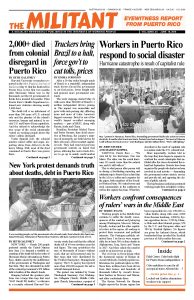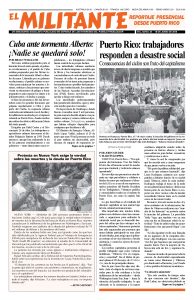Just as they were ready when Hurricane Irma hit hard last fall, Cuba’s revolutionary government and people were ready when torrential rainfalls from subtropical storm Alberto hit the western and central regions of the island at the end of May. They mobilized to minimize death and injury, relocate those in harm’s way and prepare to repair damages to infrastructure, housing and farms.
While the storm was not as devastating as major hurricanes that regularly hit Cuba and much of the Caribbean, the Cuban response stands in sharp contrast to the disdain and indifference shown by the U.S. colonial regime in Puerto Rico, where many still suffer the effects from last fall’s Hurricane Maria.
Led by Fidel Castro and the July 26 Movement, Cuban workers and farmers overthrew U.S.-backed dictator Fulgencio Batista in 1959. Though they’ve faced the wrath of the U.S. bosses and their governments — Democratic and Republican alike — ever since, Cuban toilers have control over their own destiny.
Cuban authorities issued successive Early Warning Notices as rain and thunderstorms gathered over the western Caribbean Sea. Tens of thousands of people were evacuated from areas most prone to flooding or possible mudslides. As they always do, members of the Revolutionary Armed Forces (FAR) were mobilized to help lead this effort.
In the Dos Amigos community in Encrucijada in Villa Clara province, flooding from the Alacranes reservoir prevented land evacuation. So FAR helicopters along with rescue brigades swiftly moved into action, getting some 350 people out of the area.
For those who have been evacuated, government authorities provided food and health care. Throughout the country some 250 tankers were deployed — over 100 in the central zone — to guarantee potable water to hospitals and population centers.
In Cienfuegos province, where some 9,000 people were evacuated, the vast majority decided to stay with relatives, friends and neighbors, Trabajadoresreported, while shelters were available for anyone choosing to go there.
In Villa Clara, one of the hardest hit provinces, reservoirs were filled to over 99 percent capacity with 35 areas cut off from communication. Minister of Energy and Mines Alfredo López Valdés reported May 29 that some 58,000 people nationwide were without electricity, but dozens of repair crews are getting power restored rapidly. The Cuban government had volunteered similar crews to help restore power in Puerto Rico, but the U.S. capitalist rulers refused the offer.
Seven people died in Cuba during Storm Alberto, with two still missing, reported GranmaJune 1. One of them, Quintiliano Simó Ortega, 77, was trying to cross a flooded river by horseback in Trinidad on the south central coast to get to his farm. Everyone who died was kept scrupulous track of, in sharp contrast to Puerto Rico, where colonial authorities reported only 64 had died, reports shattered by revelations this week that over 2,000 people likely died.
In a video conference with provincial authorities May 29, Cuban President Miguel Díaz-Canel said that the focus of all efforts now would be re-establishment of basic services, including water, electricity, transportation and food distribution.
In September after Hurricane Irma, the government made supplies available to working people to rebuild. Families were charged only 50 percent of the cost for construction materials.
To aid in recovery efforts, leading government officials, including First Vice President Salvador Valdés Mesa and José Ramón Machado Ventura, second secretary of the Communist Party of Cuba, were dispatched to head up work groups in the hardest hit provinces.
“No one here is ever abandoned,” Valdés Mesa affirmed.

